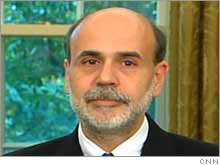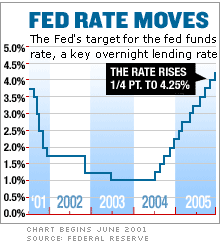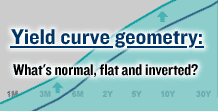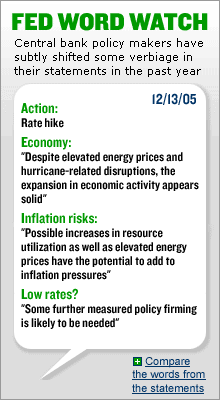Life after Alan Greenspan
Everyone expects one more rate hike from the Maestro. But what will Ben Bernanke do in March?
NEW YORK (CNNMoney.com) - Alan who? The Federal Reserve's monetary policy committee meeting on Jan. 31 will be the final one for Fed chair Alan Greenspan. But Wall Street isn't concerned about what Greenspan will do for a last hurrah.
According to futures contracts on the Chicago Board of Trade, investors are pricing in a 98 percent chance of a quarter of a percentage point rate increase. Instead, investors are more focused on what will happen once Ben Bernanke, Greenspan's successor, takes over the captain's chair of the Starship Fed. Will Bernanke be Gentle Ben when it comes to handling the economy and put an end to the Fed's recent string of interest rate hikes at his first meeting on March 28? Or will he be Big Ben the inflation fighter and raise rates one more time? Inflation is not a threat...
Assuming the Fed doesn't deviate from its painstakingly telegraphed script � and despite Greenspan's well-known love of jazz, he's not much of an improviser � Tuesday's rate hike would be the fourteenth consecutive 25 basis point increase since June 2004. (There are 100 basis points in one percentage point.) This would put the federal funds rate at 4.5 percent, its highest level in nearly five years. Banks use this rate to set their overnight lending rates. As such, it influences the amount of interest consumers pay on various types of debt, including credit cards, auto loans and home equity loans. Some argue that if the Fed boosts rates much further, there is a risk that the housing market could cool off drastically, which in turn, could cripple consumer spending. Calls for a Fed pause in March are sure to increase after the government reported Friday that the nation's gross domestic product (GDP) grew at a much lower-than-expected 1.1 percent in the fourth quarter, the lowest pace in three years. In addition, inflation does not appear to be a sizable threat. The so-called "core" consumer price index, which excludes the cost of energy and food, rose slightly in December but was in line with economists' expectations. Consumer prices have crept up by 2.2 percent during the past 12 months, an inflation rate that many economists and strategists consider to be fairly benign. With that in mind, this could be the Fed's last interest rate hike for some time. "The Fed is close to finished with raising rates. Inflation in the U.S. is moderate," said Subodh Kumar, chief investment strategist with CIBC World Markets. And Kumar resists the notion that Bernanke has to raise rates in March just to prove to Wall Street that he's going to be as vigilant an inflation fighter as Greenspan was. "Many people say a new central banker has to show that he's tough on inflation," Kumar said. "But I think it's just as relevant for him to say, 'I've looked at the data and I don't need to raise rates just to prove I'm tough.'" ...but Bernanke may have something to prove
Still, others contend that Bernanke should boost rates at least one more time in order to keep inflation at bay, especially since oil prices have recently spiked above $65 a barrel again. The Fed itself has hinted during the minutes of its past two meetings that it is almost done raising rates. After all, rates are now near a "neutral" level that should neither spark inflation nor inhibit growth. But what is "neutral" exactly? "Given that the Fed is just getting in the neighborhood of neutral, we'd be in the camp that says they go higher rather than pause or cut anytime soon," said Steve Van Order, chief fixed income strategist with Calvert Funds. "Bernanke will probably go to 4.75 percent, maybe higher." Adding to the potential confusion, some don't expect the Fed's statement on Tuesday to give any worthwhile hints either. "Tuesday's statement is going to be written with Greenspan's input and the minutes will reflect his thoughts. But what happens next will depend more on what Bernanke says when he takes over," said Brian Stine, investment strategist with Allegiant Asset Management Co. In December, the Fed made the first significant change to the language in its statement since it began tightening, saying that "further measured policy firming is likely to be needed" instead of its typical statement that "policy accommodation can be removed at a pace that is likely to be measured." Fed watchers interpreted this modification to mean that the Fed had only a few more rate hikes left before it would pause. But Van Order agreed that investors shouldn't read too much into next Tuesday's statement. Instead, he said the market should wait to see what Bernanke says during his first semi-annual testimony on monetary policy to Congress, scheduled for mid-February. Greenspan typically used these speeches to make bold proclamations about the economy, including last year's comment about how he thought low long-term interest rates were a "conundrum." Inverted yield curve could slow the Fed down
And speaking of the "conundrum," some are still worried about the fact that long-term interest rates are only a few basis points higher than short-term rates. In fact, there is a distinct possibility that, following a rate hike on Tuesday, the fed funds rate will exceed the current yield of the 10-Year U.S. Treasury note. That's a phenomenon known as an inverted yield curve. And inverted yield curves have tended to be fairly accurate predictors of a recession. But Van Order argues that the reason long-term rates have remained low is not economic weakness but the fact that foreign central banks have been scooping up U.S. bonds. (Bond rates and bond prices move in opposite directions.) He adds that as long as there is only a slight difference between short-term and long-term rates, then that should not slow down the economy. That said, some think that if the yield curve remains inverted for a prolonged period, then that would make it a lot tougher for banks to profit from lending. That could make it more difficult for consumers and corporations to borrow money. And a credit crunch would not be in anyone's best interest. So that's all the more reason why Bernanke may only need to raise rates one more time. "Historically, the Fed stops when the inversion of the overnight rate to the 10-year is about 30 to 40 basis points," said John Norris, chief economist with Morgan Asset Management. Still, Norris said the markets needn't obsess too much about how Bernanke may differ from Greenspan since they probably will wind up being fairly similar. "The Fed can't do anything different than what it has been doing. It can't rest on its laurels," said Norris, adding that the market has been through Fed chairman transitions before and will eventually get used to a new friendly Fed face. "Back in 1987 everyone was worried about Greenspan. Who was going to replace Paul Volcker?" Norris said, referring to Greenspan's uber-inflation-fighting predecessor. "We think Bernanke has the mettle to do a fine job." For a look at why Greenspan is wary of industrial banks, click here.
What will be Greenspan's new gig? Click here. |
| ||||||||||||||||||||||||||||||||||||||||||||||||||||||||||||||||||||||||||||





